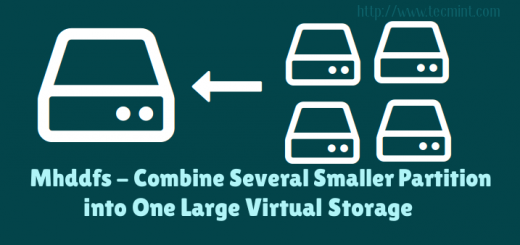How to Start/Stop and Enable/Disable FirewallD and Iptables Firewall in Linux
by Gunjit Khera | Published: January 15, 2016 | Last Updated: January 15, 2016
Download Your Free eBooks NOW - 10 Free Linux eBooks for Administrators | 4 Free Shell Scripting eBooks
Firewall is a software that acts as a shield between user’s system and external network allowing some packets to pass while discarding other’s. Firewall commonly operates on network layer i.e. on IP packets both Ipv4 and Ipv6.
Whether a packet will pass or will be bocked, depends on the rules against such type of packets in the firewall. These rules can be built-in or user-defined ones. Each packet which enters the network has to pass through this shield which verifies it against rules defined in it for such type of packets.
Each rule has a target action which is to be applied in case the packet fails to satisfy it. On Linux systems, firewall as a service is provided by many softwares, most common which are: firewalld andiptables.
In Linux there are many different types of firewalls used, but most standard ones are Iptables andFirewalld, which is going to discuss in this article.
What is FirewallD
FirewallD is the Dynamic Firewall Manager of Linux systems. This service is used to configure the network connections, thus deciding which external network or internal packets to allow traversing the network and which to block.
It allows two types of configurations, permanent and runtime. Runtime configurations will get lost ones the service is restarted while the permanent ones get retained across the system boot so that they are followed every time the service gets active.
Corresponding to these configurations, firewallD has two directories, default/fallback one (/usr/lib/firewall) which is lost ones system is updated and the system configuration (/etc/firewall) which remains permanent and overrides the default one if given. This is found as a default service in RHEL/CentOS 7 and Fedora 18.
What is Iptables
Iptables is another service which decides to allow, drop or return IP packets. Iptables service manages Ipv4 packets while Ip6tables manages Ipv6 packets. This service manages a list of tables where each table is maintained for different purpose like: ‘filter‘ table is for firewall rules, ‘nat‘ table is consulted in case of new connection, ‘mangle‘ in case of packet alterations and so on.
Each table further has chains which can be built-in or user-defined where a chain signifies a set of rules which are applies to a packet, thus deciding what the target action for that packet should be i.e. it must be ALLOWED, BLOCKED or RETURNED. This service is a default service on systems like: RHEL/CentOS 6/5 and Fedora, ArchLinux, Ubuntu etc.
To learn more about firewalls, follow the following links:
- Understanding IPtables Firewall Basics and Tips
- Configure Iptables Firewall in Linux
- Configure FirewallD in Linux
- Useful FirewallD Rules to Manage Firewall in Linux
- How to Control Network Traffic Using FirewallD and Iptables
In this article we will explain how to start, stop or restart Iptables and FirewallD services in Linux.
How to Start/Stop and Enable/Disable FirewallD Service
If you’re using CentOS/RHEL 7 or Fedora 18+ versions, you should follow below instructions to manage FirewallD service.
Start FirewallD Service
# systemctl firewalld start
Stop FirewallD Service
# systemctl firewalld stop
Check the Status of FirewallD
# systemctl status firewalld
Check the State of FirewallD
# firewall-cmd --state
As an alternative, you can disable the firewalld service so that it doesn’t apply rules to packets and enable ones needed again.
Disable FirewallD Service
# systemctl disable firewalld
Enable FirewallD Service
# systemctl enable firewalld
Mask FirewallD Service
# systemctl mask firewalld
Also, you can mask the firewall service which creates a symbolic link of the
firewall.service to/dev/null, thus disabling the service.Unmask FirewallD Service
# systemctl unmask firewalld
This is reverse of masking the service. This removes the symlink of the service created during masking, thus re-enabling the service.
How to Start/Stop and Enable/Disable IPtables Service
On RHEL/CentOS 6/5/4 and Fedora 12-18 iptables firewall comes as pre and later, the iptables service can be installed via:
# yum install iptables-services
Then, the service can be started, stopped or restarted via following commands:
Start Iptables Service
# systemctl start iptables OR # service iptables start
Stop Iptables Service
# systemctl stop iptables OR # service iptables stop
Disable Iptables Service
# systemctl disable iptables Or # service iptables save # service iptables stop
Enable Iptables Service
# systemctl enable iptables Or # service iptables start
Check Status of Iptables Service
# systemctl status iptables OR # service iptables status
On Ubuntu and some other Linux distributions however, ufw is the command which is used to manage the iptables firewall service. Ufw provides an easy interface for the user to handle the iptables firewall service.
Enable Ufw Iptables Firewall
$ sudo ufw enable
Disable Ufw Iptables Firewall
$ sudo ufw disable
Check Status of Ufw Iptables Firewall
# sudo ufw status
However, if you want to list chains in iptables which contains all the rules following command can help you achieve the same:
# iptables -L -n -v
Conclusion
These are the techniques which can help you start, stop, disable and enable the packet management services in Linux Based Systems. Different Linux distros can have different services as default, like: Ubuntu can have iptables as the default and pre-installed service, while CentOS can have firewalld as the default configured service for managing incoming and outgoing of IP packets.
Presented in this article are the most common tricks to manage these services on almost all Linux Distros, however, if you find something and would like to add on to this article, your comments are always welcome.
If you have any questions or problems regarding this article and want help within 24 Hours? Ask Now
Support TecMint: Did you find this tutorial helpful?. Please help to keep it alive by donating. Every cent counts! - Donate Now
Tags: firewall
Gunjit Khera
Currently a Computer Science student and a geek when it comes to Operating System and its concepts. Have 1+ years of experience in Linux and currently doing a research on its internals along with developing applications for Linux on python and C.
Your name can also be listed here. Got a tip? Submit it here to become an TecMint author.
Receive Your Free Complimentary eBook NOW! - Beyond Linux® From Scratch - Version 6.3
- NEXT STORYHow to Find Out Top Directories and Files (Disk Space) in Linux
- PREVIOUS STORYDeal: Learn Web Programming with This 7-Course Web Hacker Bundle
YOU MAY ALSO LIKE...
2 RESPONSES
LEAVE A REPLY
DOWNLOAD FREE LINUX EBOOKS
- Complete Linux Command Line Cheat Sheet
- The GNU/Linux Advanced Administration Guide
- Securing & Optimizing Linux Servers
- Linux Patch Management: Keeping Linux Up To Date
- Introduction to Linux – A Hands on Guide
- Understanding the Linux® Virtual Memory Manager
- Linux Bible – Packed with Updates and Exercises
- A Newbie’s Getting Started Guide to Linux
- Linux from Scratch – Create Your Own Linux OS
- Linux Shell Scripting Cookbook, Second Edition
- Securing & Optimizing Linux: The Hacking Solution
- User Mode Linux – Understanding and Administration



Im starting to set some rules in my laptop, just a question, I have 2 NIC; eth0 and eth1. Both have internet connection, so i cant deny internet package from eth1? Thanks